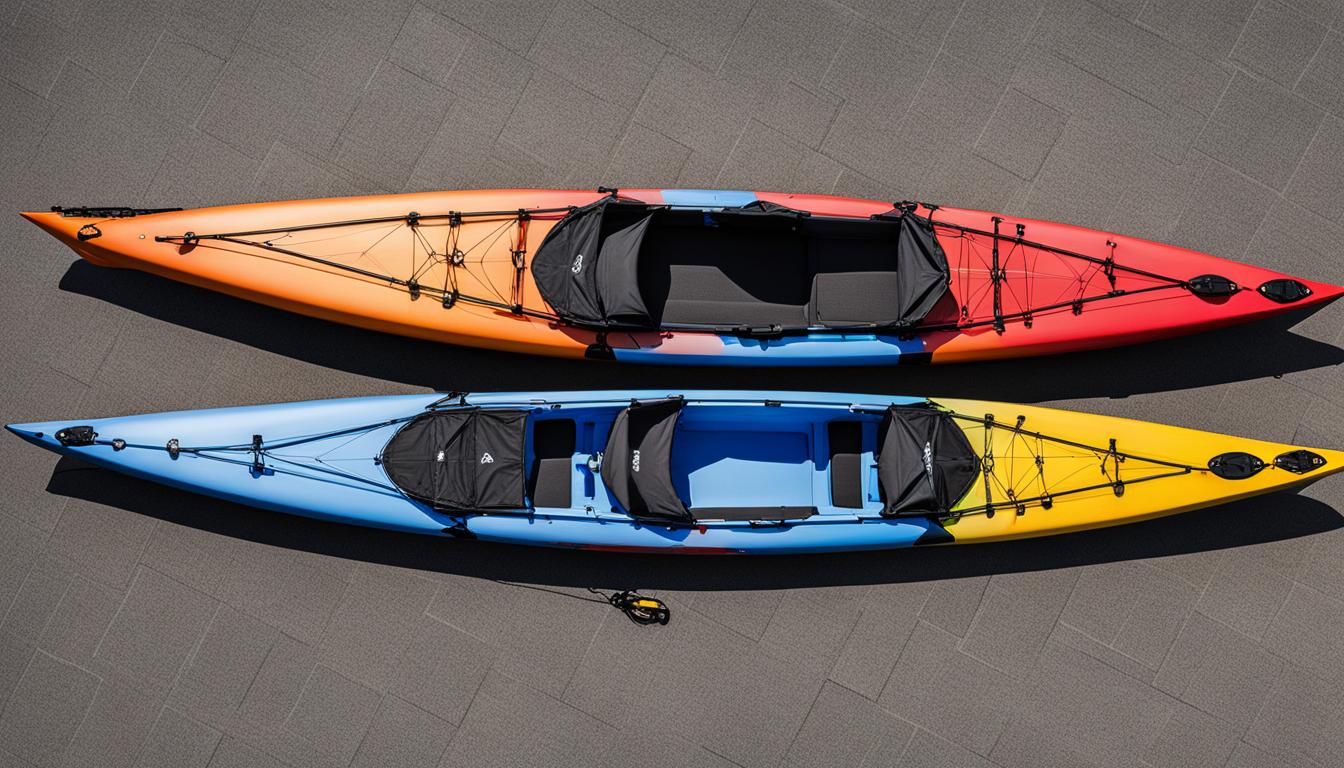Finding the right padding materials for your kayak roof racks is crucial for ensuring the safe and secure transportation of your kayak. There are various options available, including foam cushions, soft roof rack pads, and other materials specifically designed for padding kayak racks. These materials provide protection for your kayak during transit and help prevent any damage to both the kayak and the vehicle.
When choosing the best padding materials for your kayak roof racks, it’s important to consider factors such as durability, ease of installation, and the level of protection they provide. You want materials that are sturdy enough to withstand the rigors of transportation, while also being easy to use and secure.
Soft roof rack pads for kayaks are a popular choice due to their versatility and ease of use. Made from high-density foam, these pads provide cushioning and protection for your kayak during transport. They are also lightweight and easy to install, making them a convenient option for kayakers of all skill levels.
Another option to consider is kayak rack foam cushions. These cushions are designed to fit perfectly on your kayak rack and provide excellent shock absorption. They are typically made from durable closed-cell foam that won’t absorb moisture, ensuring that they remain in good condition even in wet and humid conditions.
When selecting the best padding materials for your kayak roof racks, it’s important to choose options that are suitable for your specific needs. Consider factors such as the type of kayak rack you have, the number of kayaks you’ll be transporting, and the type of vehicle you have. By selecting the right padding materials, you can ensure that your kayak stays safe and secure during transportation.
Key Takeaways:
- Choosing the right padding materials is essential for the safe and secure transportation of your kayak.
- Options like foam cushions and soft roof rack pads provide protection and prevent damage to your kayak and vehicle.
- Consider factors such as durability, ease of installation, and the level of protection when selecting padding materials.
- Soft roof rack pads are versatile and easy to use, while kayak rack foam cushions offer excellent shock absorption.
- Select padding materials that are suitable for your specific needs and ensure the safety of your kayak during transit.
Different Types of Kayak Racks and their Features
When it comes to transporting your kayak, having the right kayak rack is essential. There are different types of kayak racks available, each offering unique features and benefits. Understanding the options will help you make an informed decision and ensure a safe and secure journey for your kayak.
J-Cradles
J-Cradles are a popular choice for kayak transportation. They feature a J-shaped design that holds the kayak on its side, which is ideal for narrow roof spaces. J-Cradles provide easy side-loading access, allowing you to quickly and efficiently load and unload your kayak. With their versatile design, J-Cradles are suitable for various kayak sizes and shapes.
Saddles
Saddles are another type of kayak rack that offers excellent stability and support. These racks have a wide surface area that cradles the kayak, providing maximum contact and reducing pressure points. Saddles are particularly suitable for stormy weather conditions, as they securely hold the kayak in place, minimizing any movement during transit.
Stackers
For those who need to transport multiple kayaks, stacker racks are a great option. These racks allow you to stack kayaks vertically, maximizing the available space on your roof rack. Stackers typically feature padded arms or posts that hold the kayaks securely in place. This type of rack is convenient for group outings or when you need to transport more than one kayak.
Temporary Pads
If you’re looking for a simple and easy-to-install option, temporary pads are worth considering. These pads provide a cushioned surface for your kayak, protecting it during transit. Temporary pads are usually made of foam or rubber material and can be quickly secured to your roof rack with straps or bungee cords. They are a great choice for short trips or when you need a temporary solution.

When selecting a kayak rack, consider the type that best suits your needs and the features that provide the most convenience and protection for your kayak. Whether you opt for J-Cradles, saddles, stackers, or temporary pads, the goal is to ensure the safe and secure transportation of your kayak, allowing you to enjoy your paddling adventures without any worries.
Factors to Consider When Purchasing a Kayak Rack
When it comes to purchasing a kayak rack, there are several important factors that you should consider to ensure you make the right choice. These factors will not only impact the safety and security of your kayak during transport but also the overall convenience and durability of your rack.
Types of Kayak Rack Cushioning Options
One crucial factor to consider is the type of cushioning options available for your kayak rack. Protective padding is essential to prevent any damage to your kayak during transit. Look for options like foam cushions or soft roof rack pads that provide a cushioned surface and secure grip on your kayak. These materials are specifically designed to absorb impact and reduce the risk of scratches or dents to your kayak.
An additional consideration is the durability of the padding. Opt for durable materials that can withstand different weather conditions and prolonged use. Waterproof padding is an excellent choice as it offers protection against moisture and ensures that your kayak remains safe and dry during transport.
Compatibility with Your Vehicle and Cross Bar System
Another important factor to consider is the compatibility of the kayak rack with your vehicle and cross bar system. Ensure that the rack you choose is suitable for your vehicle’s make and model and can be easily installed and secured. Some racks are designed to be universal, while others may require specific attachment systems or adapters. Always check the manufacturer’s guidelines and specifications to ensure a proper fit.
Number of Kayaks and Additional Features
Consider the number of kayaks you plan to transport and whether the rack you choose can accommodate multiple kayaks. Some racks are designed to carry more than one kayak at a time, maximizing space and convenience. Additionally, consider any additional features that the rack may offer, such as adjustable straps or tie-down systems, which can further enhance the security and stability of your kayak during transit.
How to Securely Load and Tie Down Your Kayak
Properly loading and securing your kayak to the roof rack is essential to ensure a safe journey. Follow the manufacturer’s instructions for tie-down points and anchor locations. Use straps to secure the kayak to the rack, making sure it is tight enough to prevent slipping during travel but not overly tight to avoid damage.
When loading your kayak onto the roof rack, utilize features like sliding bars or lift assist systems if available. These can make the process easier and minimize the risk of injury. Make sure to evenly distribute the weight of the kayak on the rack to maintain stability while driving. Additionally, avoid any loose ends that could cause your kayak to come loose during transit.
To secure the kayak properly, start by placing it upside down on the rack. This provides a more stable base and prevents wind resistance. Attach the straps to the tie-down points on the rack and run them through the grab handles or attachment points on the kayak. Pull the straps tight and fasten them securely.
| Tie-Down Steps: | Tips: |
|---|---|
|
|
Remember, it’s crucial to regularly inspect the straps and kayak during transit to ensure everything is secure. Take breaks every few hours to inspect the straps and re-tighten if necessary. By following these steps, you can have peace of mind knowing that your kayak is securely loaded and ready for an enjoyable adventure on the water.

Safeguarding Your Kayak
When it comes to securing your kayak, it’s important to take the necessary precautions to protect both your kayak and your vehicle. Using proper padding materials, such as foam cushions or soft roof rack pads, can help prevent any damage during transport. Look for options that are durable, waterproof, and non-slip to ensure they stay in place throughout the journey.
In addition to securing the kayak to the roof rack, consider using bow and stern lines for added stability during long trips or windy conditions. These lines attach to the front and rear of the kayak and provide extra support to prevent any movement or shifting while on the road.
By taking the time to securely load and tie down your kayak, you’ll be able to enjoy worry-free travels and protect your investment for years to come. Whether you’re heading to the nearby lake or embarking on a cross-country kayaking adventure, following these steps will help ensure a safe and enjoyable journey.
Conclusion
Selecting the best padding materials for your kayak roof racks is essential for protecting your kayak during transportation. When choosing custom kayak rack padding, consider the specific needs of your setup. Waterproof roof rack pads for kayaks are a great choice, as they provide an extra layer of protection against water damage. Additionally, easy-to-install kayak rack padding options can save you time and effort.
By investing in high-quality padding materials, you can ensure that your kayak stays secure and in excellent condition throughout your journey. Whether you opt for foam cushions, soft roof rack pads, or other custom options, make sure they offer the necessary protection for your kayak and are easy to install. This way, you can enjoy worry-free travels and focus on the joy of kayaking.
Remember, the right padding materials can make all the difference in keeping your kayak safe and secure during transit. So, make sure to choose custom kayak rack padding that meets your needs, such as waterproof roof rack pads for kayaks and easy-to-install options. With the proper padding materials in place, you can embark on your next kayaking adventure with confidence.
FAQ
What are the different types of kayak racks and their features?
The different types of kayak racks include J-Cradles, Saddles, Stackers, and Temporary Pads. J-Cradles have a side-loading mechanism and are perfect for narrow roofs. Saddles provide a large surface area and work well in stormy weather conditions. Stackers are ideal for transporting multiple kayaks vertically, maximizing space. Temporary Pads are easy to install and remove, making them great for short trips.
What factors should I consider when purchasing a kayak rack?
When purchasing a kayak rack, consider the number of kayaks you’ll be transporting, the type of vehicle you have, the material of the rack, and the cross bar system. It’s important to ensure that the padding materials you choose provide adequate protection for your kayak during transport.
How do I securely load and tie down my kayak?
To securely load and tie down your kayak, follow the manufacturer’s instructions for tie-down points and anchor locations. Use straps to secure the kayak to the rack, making sure it is tight enough to prevent slipping during travel but not overly tight to avoid damage. Utilize features like sliding bars or lift assist systems if available. Make sure to evenly distribute the weight of the kayak and avoid any loose ends that could cause your kayak to come loose during transit.





